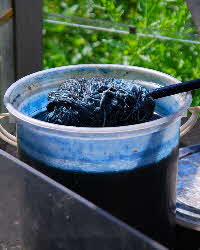|
Getting a dark blue
 9. Remove fibre and expose to the air for an hour. Rinse. Dip the fibre into the vat for a few minutes and expose it for 15 minutes. Repeat several times to get a dark blue. Leave to air overnight or for 48 hours. Rinse well. 9. Remove fibre and expose to the air for an hour. Rinse. Dip the fibre into the vat for a few minutes and expose it for 15 minutes. Repeat several times to get a dark blue. Leave to air overnight or for 48 hours. Rinse well.
10. Between dyeing sessions the vat must rest overnight or an extra day. Whenever the dye weakens, you can renew it by adding more woad and the other ingredients in proportion. The vat will take four to five days to get ready again. The vat can last for a long time and some indigo vats are over 100 years old. I keep my vat going over the summer. When it becomes too cold for the vat to work, I throw the contents onto the compost and start again the following summer.
Back to Top
|